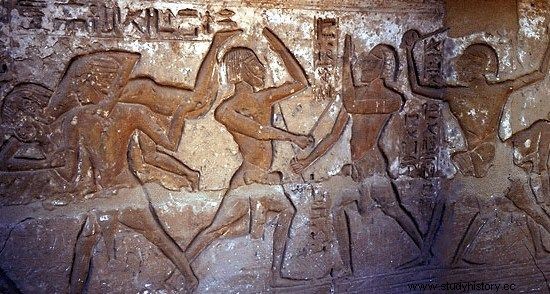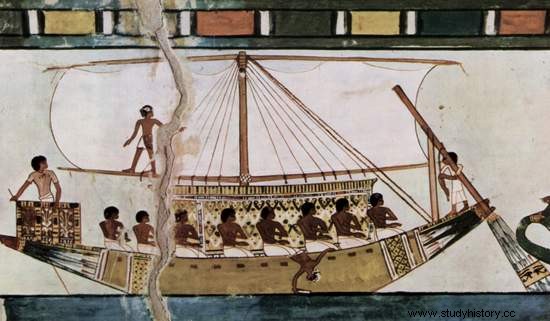The Egyptians did not invent the sport, but they undoubtedly made a real revolution in its history. It was on the Nile that the first team games appeared, the first named athlete lived there and the rules of fair play were implemented.
Egyptian sport was inextricably linked with religion, but also with a demonstration of strength. By far the most popular physical entertainment was wrestling, grown by both teenagers and adults. Ancient bas-reliefs - a fundamental source of the history of Egyptian sport - depict wrestlers, enthusiastic crowds (people with gaping mouths) and even judges.
On the walls of tombs and temples, images of fist fights were also found, including probably the first image of a fight in history !! In the tomb from the time of Amenhotem III (circa 1365 BC) figures of 12 fighting boxers were forged.

Sekhet. Egyptian goddess of swamps, hunting and… sport (photo:Gérard Ducher; license CC ASA 2.5).
Pushers and ... papyrus warriors?
On the same bas-relief, seven more men practice fencing. The Egyptians also knew the sport, except that they did not use any really dangerous tools for it. Most often they fought with sticks. Wojciech Lipoński, the author of the book "History of sport", even described a satirical papyrus with a funny drawing of a cat fighting with a mouse on sticks (p. 39).
Speaking of papyri, it must be added that they were also used for fencing! Duels with fingers made of papyrus scrolls is a popular theme for bas-reliefs. Most were fought on the occasion of religious holidays and state ceremonies.
A healthy pharaoh in a healthy body
Even rulers - the great pharaohs of ancient Egypt - took part in the official competitions. An inscription says that the pharaoh Amenhotep II took part in a rowing competition : His Royal Highness was still strong, wielding an oar twenty feet long. He stopped, anchored his boat, having traveled three miles without stopping. (…) The others stopped half a rail behind him (p. 41) .

It was the Egyptians who were probably the first to immortalize the fight.
On another occasion, the same pharaoh organized an archery competition . The inscription announced that: All those who hit the target where his Majesty's arrow struck would receive a reward (p. 44). As you can see, the organizer was in the winning position in advance:everyone was shooting where he was. Regardless of whether he himself hit any target…

Amenhotep II. The most athletic of the pharaohs? (photo by Jean-Pierre Dalbera; license CC ASA 2.0).
Despite these forums, Amenhotep still paved the way for sports ethics. As Wojciech Lipoński explains: showed [he] a friendly attitude towards his competitors, without the ruler's typical contempt for his subjects. So we can talk about honorable behavior, which will be called fair play for centuries (p. 41).
Amenhotep II also showed off running and reportedly had no equal (p. 41). Overall, he appeared to be a kind of pharaoh-athlete. He was not the first such delinquent. A certain Egyptian prince, Jehutti-Nakht el Bersheh earned himself a nickname a game freak in the hunt. Hunting, of course, was considered a sport, and the Egyptians even had their hunting goddess. On Sekht, because that's what we're talking about, it was called your chase or your hunting lady. Some historians even call her The Lady of Sports.
Did the Egyptians play soccer?
At the end of this short review, it is also worth mentioning team games. The peculiar competition, perhaps the first in which a team division was used, was held every year at the Papremis Temple.

Amenhotep II not only was an excellent archery, he was also a great rowing machine.
Supporters of Osiris and Isis formed there a kind of "fake" combat team, which, armed with sticks, stormed the gates of the temple. Her attack was repelled by priests dressed as followers of evil. As Lipoński writes, the fight with sticks was fierce, but conventional; the chronicles did not record a single fatal accident. The fight ended with the conquest of the temple by the followers of Osiris, so good (p. 37) .

The article is based on the book by Wojciech Lipoński entitled "History of sport" (Polish Scientific Publishers PWN, 2012).
As you can see, the Egyptians were not only among the first athletes. They can also be called precursors of… historical reconstructions !! At first glance, the game of football seems to be more familiar. But only at first glance.
Many balls have been found in the tombs of children's mummies. They were churned with grass or reeds and trimmed with red-dyed leather. One of the games with such a ball is described in the History of Sport. I am talking about the performance: players throwing the ball to each other while sitting "piggyback" on the backs of people not directly participating in the game (p. 43).
Sounds weird? It's still nothing. The Egyptians had many even more exotic games. For example, in the tomb of a certain Mereruk, a bas-relief was found depicting a game in ... "bringing a prisoner" . Six running boys surround the seventh, his hands tied. The essence of the game is probably to break free from captivity or to get a prisoner from the opposing team (p. 45) . It's just a sport for you…
Source:
Wojciech Lipoński, History of sport , Polish Scientific Publishers PWN, 2012.
